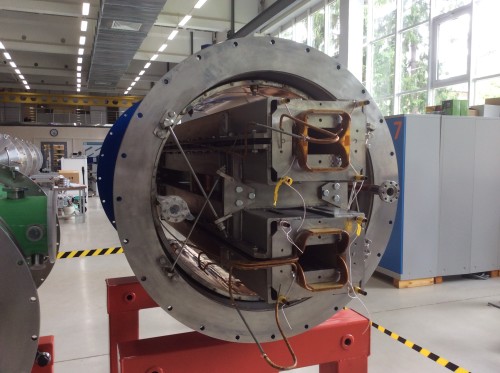
Zero resistance: the JINR is building superconducting magnets for both its new NICA facility and the FAIR heavy-ion collider being constructed at GSI Darmstadt.
By Susan Curtis
When our visit was running two hours behind schedule by lunchtime, I knew it was going to be a mind-expanding day. And there was certainly plenty to discover at the Joint Institute of Nuclear Research (JINR) in Dubna, some 120 km north-west of Moscow.
An international research centre bringing together 18 member states, the JINR has been in the news for its discovery of new superheavy elements (SHEs). According to Andrei Popeko, deputy director of the JINR’s Flerov Laboratory for Nuclear Reactions, all of the last six elements were first synthesized at the laboratory’s U400 cyclotron, in most cases using samples prepared at Oak Ridge National Laboratory in the US. The JINR is now building the world’s first SHE factory that will boost production efficiency by a factor of 50, which will allow the lab’s scientists to investigate the chemical properties of these short-lived elements.
But plenty of other projects are set to hit the headlines in the coming years. Perhaps most significant is a new heavy-ion collider, NICA, that’s now being built by the JINR’s Laboratory for High-Energy Physics. NICA will combine high luminosity with an energy regime of 4–20 GeV, which will allow physicists to probe the processes underpinning the emergence of baryonic matter from the quark–gluon plasma around 100 ms after the Big Bang. With a similar remit to the FAIR project being developed at GSI Darmstadt in Germany, the two facilities are collaborating on technical design and implementation, and will take complementary experimental approaches to try to reveal new physics beyond the Standard Model.
The JINR also boasts one of world’s largest programmes in neutrino physics. The first module of the Baikal Deep Underwater Neutrino Observatory was installed at the bottom of Lake Baikal in 2015, and when additional modules are deployed in 2020 the instrument will be as powerful as the IceCube experiment in Antartica. “Baikal has very clear water,” commented the JINR’s deputy director Richard Lednicky. “IceCube will look at the southern atmosphere, while Baikal will look at the northern atmosphere.”
The JINR is also contributing to neutrino experiments in other parts of the world, notably the JUNO neutrino observatory now being constructed in China and the NOvA experiment at Fermilab in the US, which is investigating the physics of neutrino oscillations. To facilitate the collaboration with Fermilab, a remote operations centre has been installed at the JINR to allow the experiment to be continuously monitored, with Russian operators taking the “night shift”.
By the end of the day, we had visited four of the JINR’s seven laboratories and spoken to scientists from Slovakia, Romania and Poland alongside their Russian colleagues. Lednicky told us that JINR was the only international research centre to survive the crisis that rocked Russian science in the 1990s, and it’s not hard to see why.
Nice to visit the very active international JINR,Dubna. without any “bearish” connotation or “from the cold” syndrome. Moreover, the SHE element with Z=114 has been officilly named as “Flerovium” for his group’s discovery of the SHE’s in the “warm fusion” reaction in JINR, Dubna.